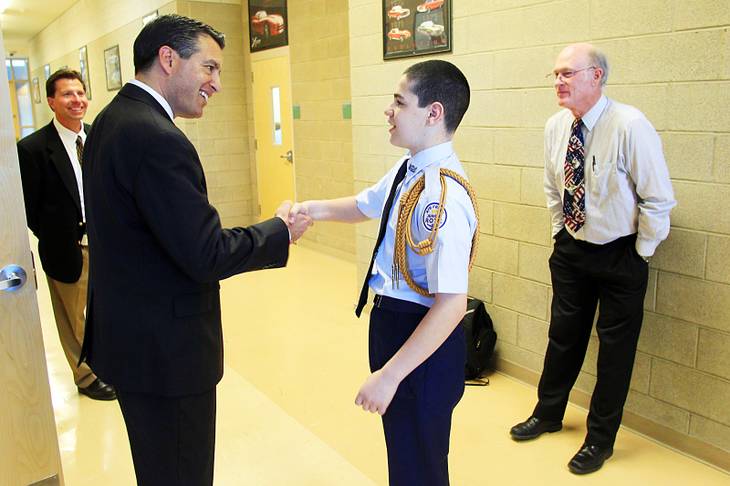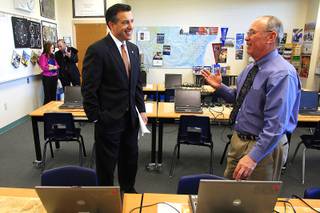Acting on his vision of Southern Nevada becoming the Silicon Valley of the civilian unmanned aircraft industry, Gov. Brian Sandoval paid a visit Thursday to students who are learning aeronautics and could help the state reach that goal.
Knowing Nevada already is a hub for the operation for unmanned military aircraft, Sandoval met with students in Rancho High School's aviation magnet school program and with students seeking advanced aeronautical degrees at Embry-Riddle Aeronautical University at the North Las Vegas Airport.
The aeronautical industry is one of the components in the governor's economic diversification effort, and Sandoval hopes the state can capitalize on resources in place at Nellis and Creech air force bases to develop civilian applications for unmanned aircraft systems — known within the industry as UASs
Last month, Congress directed the Federal Aviation Administration to develop regulations to make airspace available to civilian UASs by 2015. Six unmanned aircraft system test sites will be selected to advance the program, and Sandoval wants Southern Nevada to be one of those sites.
"We're definitely going to be in the game," Sandoval said after speaking to Rancho students.
Being a UAS test site has the potential for driving millions of dollars in aeronautics industry resources to the state. Unmanned aircraft, sometimes called drones, already have some civilian applications, with camera- and sensor-carrying aircraft spotting wildfires and monitoring police pursuits. Drones also are used to observe illegal border crossings in remote areas.
Unmanned military aircraft also are piloted from Creech, north of Las Vegas, on combat missions in the Middle East.
Tom Wilczek, director of defense and aerospace programs for the Governor's Office of Economic Development, said part of the process will be determining other commercial applications for drone aircraft and convincing the federal government that Nevada is an ideal location for the testing of UASs.
A 60-day comment period on the development of test sites opened on March 9.
State leaders figure Nevada has an excellent chance of being selected one of the six sites, since government officials want to measure performance of vehicles in a variety of climates and conditions. The state also is home of military personnel that know the technology, and as the government draws down its military presence abroad, it will have experts in the field seeking civilian work.
Having credible educational facilities also will help, and Sandoval wanted to get a first-hand look at the facilities at Rancho, which has a program in which students earn a private pilot license. An aerospace engineering program gives students the opportunity to design and build airplanes, and a team of Rancho students is in a national design competition sponsored by the FAA. The team is using $1 million worth of computer software and equipment Rancho has acquired for the magnet program.
Embry-Riddle has its primary campuses in Daytona Beach, Fla., and Prescott, Ariz., with smaller classroom settings at Nellis, North Las Vegas Airport and Naval Air Station Fallon in Northern Nevada.
Kenneth Witcher, the chair of Embry-Riddle's master of aeronautical science program in Las Vegas, said at least half of the school's students attend class online and a large percentage of students are either in the military or National Guard.

